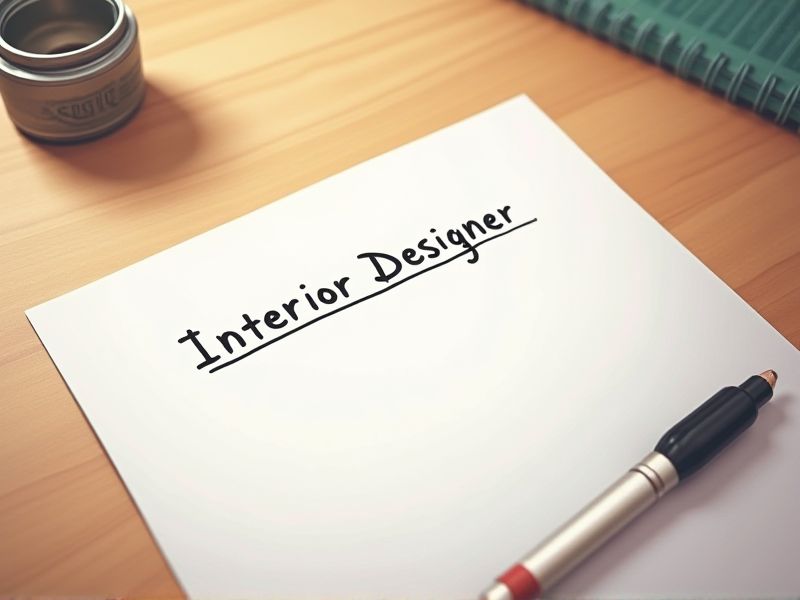
Interior designers often require specific certifications to validate their skills and knowledge in creating functional and aesthetically pleasing spaces. These certifications ensure designers are well-versed in safety, building codes, and sustainable design practices, leading to enhanced client trust. In competitive markets, possessing recognized credentials can significantly differentiate a designer from peers, providing a competitive edge. Noteworthy certifications that may be essential for an interior designer include the following.
NCIDQ Certification
Earning the NCIDQ Certification validates an interior designer's competency and expertise, ensuring adherence to industry standards. Many employers and clients prioritize certified designers, increasing job opportunities and professional credibility. The certification process involves rigorous testing on essential aspects like safety codes and ethical practice, which reduces risks in project execution. Differentiating oneself in a competitive market becomes possible as the certification is a recognized benchmark of proficiency and dedication in the field.
LEED Green Associate
The LEED Green Associate credential provides interior designers with a foundational understanding of sustainable design principles, which enhances their ability to create environmentally responsible spaces. Clients increasingly demand sustainable solutions, so possessing this credential can differentiate interior designers in a competitive market. Knowledge from LEED Green Associate helps designers make informed material choices that improve energy efficiency and indoor environmental quality. This credential demonstrates a designer's commitment to sustainability, potentially increasing career opportunities and project scope.
LEED Accredited Professional (LEED AP)
An interior designer with LEED AP credentials can effectively integrate sustainable practices into design projects, enhancing environmental performance. Mastering LEED standards allows the designer to contribute to creating spaces that meet green building criteria, which often translates to long-term cost savings and increased marketability for clients. Many clients and companies prioritize sustainability, and having a LEED AP enhances the designer's credibility and competitiveness in the industry. Knowledge in energy efficiency, air quality, and material sustainability can ensure that designs achieve high LEED certification levels, endorsing the project's commitment to eco-friendly principles.
WELL Accredited Professional (WELL AP)
Becoming a WELL Accredited Professional (WELL AP) equips an interior designer with specialized knowledge in health-focused design principles, aligning their work with the globally recognized WELL Building Standard. The accreditation helps designers integrate evidence-based interventions and strategies that enhance occupants' well-being in built environments. Demand for healthier, more sustainable interiors continues to rise, influencing client decisions and industry trends, thereby increasing the value of WELL AP credentials. Possessing a WELL AP designation positions an interior designer as a leader in the field, differentiating them from peers and potentially increasing career opportunities.
Certified Kitchen and Bath Designer (CKBD)
Certified Kitchen and Bath Designers (CKBD) possess specialized knowledge in the functional and ergonomic design of these essential spaces. This expertise ensures that kitchens and bathrooms are not only aesthetically pleasing but also highly efficient and tailored to user needs. The CKBD certification also requires knowledge of safety codes and sustainable practices, which are critical in these two areas. Collaborating with a CKBD reduces costly design mistakes and enhances client satisfaction through well-executed and compliant renovations.
Certified Aging-in-Place Specialist (CAPS)
A Certified Aging-in-Place Specialist (CAPS) is essential for interior designers to ensure homes are accessible and safe for aging individuals. The CAPS designation equips designers with the knowledge to incorporate universal design principles, which can reduce the risk of falls and injuries. As the population ages, there's an increasing demand for living spaces that allow for aging gracefully without the need for relocation. By integrating CAPS principles, designers can enhance the marketability of their services and contribute to the well-being and independence of older adults.
Autodesk Certified Professional - AutoCAD
The Autodesk Certified Professional - AutoCAD credential enhances an interior designer's proficiency and reliability, ensuring accurate and efficient design plans. Certification validates one's skills, often leading to increased job opportunities and professional credibility. Mastery in AutoCAD is essential for interior designers to create detailed drawings and effective floor plans tailored to client specifications. Employers frequently prefer candidates who can demonstrate a high level of technical expertise, which a certification in AutoCAD provides.
Autodesk Certified Professional - Revit
Becoming an Autodesk Certified Professional in Revit enhances an interior designer's proficiency in creating accurate and detailed 3D models, essential for visualizing space layouts. This certification demonstrates a designer's commitment to maintaining industry standards, which can increase client trust and expand business opportunities. Mastery of Revit aids in efficient project management, reducing errors and saving time during the design and construction phases. The certification provides a competitive edge in the job market, appealing to employers who value technical expertise and innovation.
Certificate in Sustainable Interior Design
The Certificate in Sustainable Interior Design equips interior designers with the knowledge to integrate eco-friendly materials, which reduces environmental impact. This specialized certification enhances a designer's ability to innovate with energy-efficient solutions, meeting the increasing client demand for sustainable spaces. Gaining expertise in sustainable practices helps designers stay competitive in an industry where environmental consciousness is becoming a critical factor. Formal training in sustainability principles ensures that designers meet legal standards and contribute to healthier living environments.
Certified Interior Designer (CID)
Hiring a Certified Interior Designer ensures compliance with building codes, as they possess knowledge of regulations and standards essential for safe and functional spaces. Their expertise in material selection leads to cost-effective decisions, minimizing waste and ensuring durability. Certified designers have a trained aesthetic sense, enhancing the visual appeal of spaces while maintaining functionality. Collaborating with a CID streamlines project management, reducing delays and unforeseen costs due to their professional experience.
Summary
As an individual seeking interior design services, you can expect a certified interior designer to possess verified skills and industry knowledge. Certification often leads to enhanced design quality, as it requires designers to meet specific educational and professional standards. Certified professionals typically have a broader understanding of materials, codes, and ergonomics, which can improve project outcomes. Trust and credibility in the designer-client relationship usually increase when a designer holds recognized certifications.
